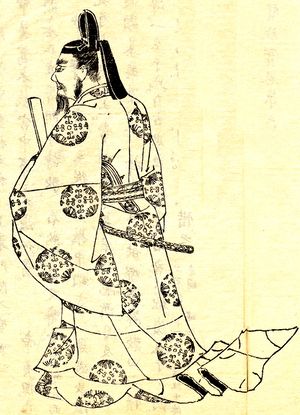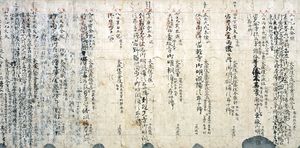فوجيوارا نو ميتشيناغا
Fujiwara no Michinaga 藤原道長 | |
|---|---|
 Fujiwara no Michinaga — drawing Kikuchi Yōsai (1781-1878) | |
| Daijō-daijin | |
| في المنصب 24 ديسمبر 1017 – 27 فبراير 1018 | |
| العاهل | Emperor Go-Ichijō |
| تفاصيل شخصية | |
| وُلِد | 966 |
| توفي | 3 يناير 1028 (aged 62) |
| الأنجال | فوجيوارا نو شوشي (الإبنة الأولى) فوجيوارا نو يوريميتشي (الابن الأول) Fujiwara no Kenshi (الابنة الثانية) فوجيوارا نو نوريميتشي (الابن الخامس) فوجيوارا نو إيشي (الإبنة الرابعة) فوجيوارا نو كيشي (الإبنة السادسة) |
| الوالدان | Fujiwara no Kaneie |
| الأقارب | Fujiwara no Michitaka (شقيقه) Fujiwara no Korechika (ابن أخيه) Fujiwara no Teishi (ابنة أخيه) Princess Teishi (حفيدة) Emperor Ichijō (الصهر الأول) Emperor Sanjō (الصهر الثاني) Emperor Go-Ichijō (الصهر الرابع) Emperor Go-Suzaku (الصهر السادس) |
فوجيوارا نو ميتشيناگا (藤原道長, 966 - 3 يناير 1028) رجل دولة ياباني. وهو من الشخصيات المؤثرة في التاريخ الياباني لـ"فترة هـِيْآن"، ارتبط اسمه بأوج سيطرة عشيرة فوجيوارا" (藤原) على اليابان وعلى الحياة السياسية.
كان "ميتشيناگا" خامس إخوته، أبوه "كانـِهإييـِه Kaneie" ع.(929-990) تولى منصب الـ"وصي" أو "سيشو" (摂政). بعد وفاة أخويه سنة 995 أصبح عميد عشيرة فوجيوارا، خلع عليه لقب "نائيران"، وأصبح له بذلك حق الإطلاع على جميع الوثائق التي يتم تقديمها للإمبراطور. تمكن بفضل منصبه من أن يكون شبكة قوية من العلاقات. عمل "ميتشيناگا" على تكريس هذه العلاقات طوال بقية عمره.
حتى يدعم موقع في الدولة ويكتسب شرعية أكبر، قام بتزويج ثلاث من بناته من أباطرة. ابنته الكبرى تزوجت من الإمبراطور "إشيجو" ( 986-1011 ) (الـ66)، أنجت معه اثنين من الأبناء، أصبحا بدورهما إمبراطورين، "گو-إشيجو" (1016-1036) و "گو-سوزاكو" (1036-1045). ابنته الثانية تزوجت من الإمبراطور "سانجو" (1011-1016). أما ابنته الثالثة فتزوجت من حفيده الإمبراطور "گو-إشيجو" (1016-1036).
تولى "ميتشيناگا" سنة 1017 منصب وزير الشؤون العليا "داجو دايجن"، ثم بعدها بقليل تولى منصب الوصي "سيشو" (摂政) على حفيده الإمبراطور "گو-إشيجو". إلا أنه ولأسباب خاصة فضل أن يترك هذا المنصب لينعزل في المعبد الذي قام بتشييده في "كيوتو"، الـ"هوجو-جي". كان "ميتشيناگا" يمسك وعن طريق أبناءه بمقاليد الحكم الفعلي. شغل العديد من أبناءه مناصب كبيرة في الدولة، كما تولى اثنين منهم منصبي الحاجب (كبير المستشارين) "كانباكو" (関白) ووزير الشؤون العليا "داجو دائي-جن". تولى أكبر أبنائه "فوجيوارا نو يوريميشي" (992-1074) وعلى مدى 52 سنة منصب الوصي "سيشو" (摂政) على ثلاث أباطرة،.
كان "ميتشيناگا" من أتباع مذهب "آميدا" البوذي، وكرس أغلب وقته لخدمة معتقداته. توفي سنة 1027، في إقامته في معبد الـ"هوجو-جي". يعتقد البعض أن شخصيته القوية هي التي أوحت بكتابة "قصة گنجي" (源氏物語)، وأن أحداث القصة كانت تدور حول حياته الشخصية.
. . . . . . . . . . . . . . . . . . . . . . . . . . . . . . . . . . . . . . . . . . . . . . . . . . . . . . . . . . . . . . . . . . . . . . . . . . . . . . . . . . . . . . . . . . . . . . . . . . . . . . . . . . . . . . . . . . . . . . . . . . . . . . . . . . . . . . . . . . . . . . . . . . . . . . . . . . . . . . . . . . . . . . . .
وفاته
توفي ميچيناگا في 3 يناير 1028 (مانجو 4، اليوم الرابع من الشهر الثاني عشر) عن عمر 62 عاماً.
ذكراه
 جزء من اليوميات الشخصية لميچيناگا بخط يده — النص هنا هو من المجلد الذي يغطي الأعوام من 998 إلى 1021، وقد اُعتُبر كنزاً وطنياً لليابان في قسم الوثائق القديمة. |
ترك ميچيناگا يوميات، ميدو كانپاكوكي (御堂関白記)، وهي واحدة من مصادرنا الرئيسية للمعلومات عن حياتة البلاط في فترة هـِيْآن في أوجها.
- تقييم ذاتي
-
- "هذا العالم، على ما أعتقد،
هو في الواقع مِلكي.
مثل البدر أُضيء،
لا تحجبني غيوم."
- "هذا العالم، على ما أعتقد،
الشخصية
Michinaga was reputed to be a skilled horseman and archer, and was perceived as courageous. His friends praised his poetry and he was reputed to have strong self-control. He clearly had a remarkable understanding of people and the human heart, given the success of his machinations - the Fujiwara were strongest under his control, despite a broader trend of the power of the sovereigns weakening and that of the provincial warrior clans growing.[بحاجة لمصدر]
He had a taste for opulence and luxury, holding extravagant parties and entertainments, though it was nonetheless governed by the tasteful modesty that characterises the Heian period. His extravagance had a purpose, however - it openly demonstrated the wealth and power of the Fujiwara clan, impressing allies and intimidating rivals.[بحاجة لمصدر]
Michinaga may have been pious, given his vast expenditure on shrines and temples, though this may have been another manifestation of the aforementioned excess. On the other hand, he was known to sternly rebuke courtiers who neglected Shinto ceremonies. He was a devoted follower of the Lotus Sutra; his copy had the words embellished in gold. When Amidist Pure Land Buddhism began to grow and develop during his rule, Michinaga supported and adopted its teachings.[بحاجة لمصدر]
Michinaga was very proud of his achievements, as demonstrated by his poem, Mochizuki no Uta (望月の歌) (Full Moon Poem), which he composed in 1018 at a party to celebrate Ishi becoming Chūgū to Go-Ichijō: "This world, I think/ Is indeed my world./ Like the full moon I shine,/ Uncovered by any cloud".[بحاجة لمصدر]
النسل
He was married to Minamoto no Rinshi, otherwise known as Michiko (源倫子), daughter of Sadaijin Minamoto no Masanobu. They had six children.
- Shōshi (彰子) (Jōtōmon-in, 上東門院) (988–1074) – consort of Emperor Ichijō.
- Yorimichi (頼通) (992–1074) – regent for Emperor Go-Ichijō, Emperor Go-Suzaku, and Emperor Go-Reizei.
- Kenshi (妍子) (994–1027) – consort of Emperor Sanjō.
- Norimichi (教通) (996–1075) – regent for Emperor Go-Sanjō and Emperor Shirakawa.
- Ishi (威子) (999–1036) – consort of Emperor Go-Ichijō.
- Kishi (嬉子) (1007–1025) – consort of Crown Prince Atsunaga (later Emperor Go-Suzaku).
He was also married to Minamoto no Meishi (源明子), daughter of Sadaijin Minamoto no Takaakira. They had six children.
- Yorimune (頼宗) (993–1065) – Udaijin.
- Akinobu (顕信) (994–1027) – He became a priest at the age of 19.
- Yoshinobu (能信) (995–1065) – Gon-no-Dainagon.
- Kanshi (寛子) (999–1025) – consort of Imperial Prince Atsuakira (Ko-Ichijō-in).
- Takako (尊子) (1003?–1087?) – married to Minamoto no Morofusa.
- Nagaie (長家) (1005–1064) – Gon-no-Dainagon.
Michinaga had one daughter from an unknown woman.
- Seishi (盛子) (?–?) – married to Emperor Sanjō
ببليوجرافيا
- Brown, Delmer M. and Ichirō Ishida, eds. (1979). Gukanshō: The Future and the Past. Berkeley: University of California Press. ISBN 978-0-520-03460-0; OCLC 251325323
- Hioki, S. (1990). Nihon Keifu Sōran. Kodansya. (in يابانية)
- Kasai, M. (1991). Kugyō Bunin Nenpyō. Yamakawa Shuppan-sha. (in يابانية)
- Owada, T. et al. (2003). Nihonshi Shoka Keizu Jimmei Jiten. Kodansya. (in يابانية)
- Ponsonby-Fane, Richard Arthur Brabazon. (1959). The Imperial House of Japan. Kyoto: Ponsonby Memorial Society. OCLC 194887
- Titsingh, Isaac. (1834). Nihon Odai Ichiran; ou, Annales des empereurs du Japon. Paris: Royal Asiatic Society, Oriental Translation Fund of Great Britain and Ireland. OCLC 5850691
- Tsuchida, N. (1973). Nihon no Rekishi No.5. Chūō Kōron Sha.
- Varley, H. Paul. (1980). Jinnō Shōtōki: A Chronicle of Gods and Sovereigns. New York: Columbia University Press. ISBN 978-0-231-04940-5; OCLC 59145842
- Sansom, George (1958). A History of Japan to 1334. Stanford University Press. ISBN 978-0804705233.
انظر أيضاً
المصادر
- Short description is different from Wikidata
- Articles containing Japanese language text
- Articles with unsourced statements from November 2023
- Articles with يابانية-language sources (ja)
- مواليد 966
- وفيات 1028
- عشيرة فوجيوارا
- بوذيو القرن العاشر
- بوذيو القرن 11
- أشخاص من فترة هـِيْآن في اليابان
- Heian period Buddhist clergy
- بوذيون يابانيون
- Japanese diarists
- بوذية الأرض الطاهرة
- بوذيو الأرض الطاهرة
- أوصياء اليابان
- Sesshō and Kampaku
